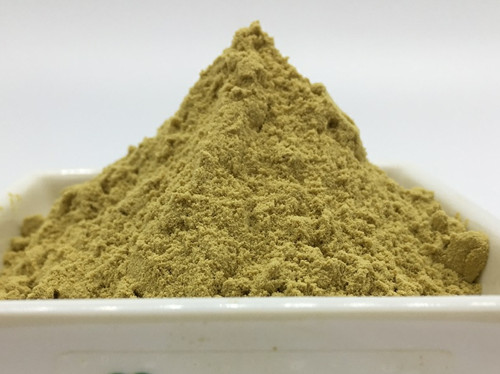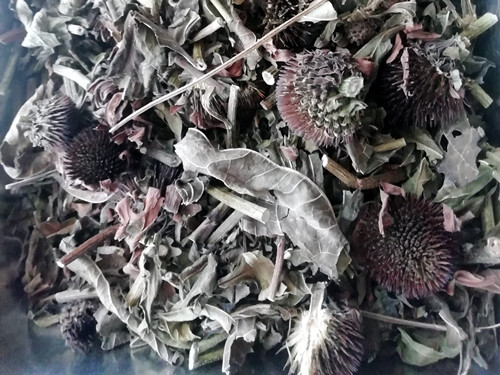Chicoric acid, also known as caftaric acid, or dicaffeoyl tartaric acid, is a hydroxycinnamic acid (HCA) that occurs in a variety of plants, including Cichorium intybus, Echinacea angustifolia and Echinacea purpurea. It has been reported to have a number of health benefits including antioxidant, anti-viral, anti-inflammatory and insulin enhancer properties, has been used as supplements for the prevention of diabetes, obesity, immunity improvement and skin protection. Its presence in medicinal and food homologous species has led to a surge in the dietary consumption of plant phenolics.
What’s Chicoric Acid?
Chicoric acid is a major phenolic compound, widely distributed in plants. Its presence in medicinal and food homologous species has led to a surge in the dietary consumption of plant phenolics. Despite this, the chemical synthesis of chicoric acid remains challenging. Many synthetic methods have been developed but none bring the highest purity, yield, and economic and environmental protection. A phenyl-propanoid pathway is generally used to synthesize chicoric acid (Kuhnl et al., 1987; Petersen et al., 2009).
The natural chicoric acid varies in different parts of a plant and depends on resource distribution, growing conditions, and post-harvest and processing techniques. It can be extracted via several methods including high performance liquid chromatography (HPLC). Its content varies depending on the plant source, medicinal parts, harvest period, processing and extraction methods. For example, chicoric acid was lower in baby romaine lettuce leaves that were exposed to different salinity treatments than in the same leaf samples grown without any salt application.
However, it is not clear how much Chicoric acid is produced by different plant species or the amount it accumulates throughout a plant in relation to its growing condition and varying levels of maturity within a given organ or tissue. This is important for growers and producers of herbal products who may need to take this into consideration before scheduling harvest dates or planning product manufacturing.

Echinacea Chicoric acid
Benefits of Chicoric Acid
Chicoric acid has been studied for its potential health benefits, research suggests that it may have antioxidant, antiviral, and anti-inflammatory properties. However, these benefits are still not well understood.
Anti-inflammatory activity
In vivo and in vitro studies have demonstrated the anti-inflammatory activity of chicoric acid. It inhibited induction of nitric oxide synthase (iNOS), prostaglandin E2 (PGE2), and tumor necrosis factor-a (TNF-a). Moreover, chicoric acid also reduced the levels of inflammatory mediators, such as TNF-a, IL-1b, and malondialdehyde. It also promoted the redox balance of cells by regulating the Nrf2 signaling pathway. It also up-regulated expression of antioxidant defense enzymes, both in vivo and in vitro.
Chicory acid, as a phenolic compound, has high scavenging ability of oxygen free radicals. Cichoric acid can promote the generation of antioxidant enzymes in different cells, reduce intracellular ROS levels, protect cells from free radical induced cytotoxicity, play a pharmacological role in antioxidant damage, and exert antioxidant activity by mediating Keapl/Nrf2, NF-KB, MAPK oxidative stress pathways. The addition of low concentration of chicory acid can significantly inhibit the oxidative damage of hydroxyl free radicals to macromolecular substances, and can also reduce the level of oxidative stress through the rate-limiting effect on free radicals. However, high concentration of chicory acid can promote the oxidation of hydroxyl free radicals, and in dealing with the oxidative damage of alkyl free radicals, its inhibitory effect is linearly correlated with the concentration of chicory acid.

Dry Echinacea
Improve immunity
The Echinacea angustifolia, Echinacea pallida, and Echinacea purpurea have a long history of medicinal use as immunomodulators and immune promoters. The chicory acid extracted from the plant can effectively regulate the immune response of macrophages in vitro and significantly reduce the level of NO. Cichoric acid treats chronically stressed mice by regulating norepinephrine (NA), dopamine (DA), and serotonin (5-HT). Cichoric acid regulates stress resistance by increasing plasma corticosterone levels to promote adequate levels of ascorbic acid, cholesterol, and corticosterone, and promotes immune response in stressed mice.
Lower blood sugar
Chicory acid is a kind of phenolic acid, which can regulate the disorder of glucose metabolism and has the effect of lowering blood sugar. 50% ethanol Echinacea chichoric acid (IC, 0.28 g/L) inhibited α-glucosidase associated with type 2 diabetes in a concentration-dependent manner, showing good potential for controlling hyperglycemia and hypertension. Chicory acid can alleviate the weight loss of diabetic mice, increase the exercise speed and activity of mice, reduce blood sugar, increase fasting insulin concentration, reduce insulin resistance index, improve insulin sensitivity and glucose sensitivity. Cholicylic acid alleviates the islet apoptosis induced by streptozotocin (MTD-STz) by inhibiting mitochondrial wide-death signaling, and affects glucose uptake and glycogen synthesis ability of cells through insulin signaling pathway, alleviates functional damage, improves insulin resistance of adipocytes, and has the potential function of regulating glucose homeostasis and improving diabetes and its complications.
In addition, In one study, chicoric acid was found to inhibit HIV replication in vitro—although more research needs to be done to determine if the same effects would occur in humans. Studies have also suggested that chicoric acid has potential anti-allergic, neuroprotective and cardioprotective properties.
In conclusion, chicoric acid is a naturally occurring polyphenol that may have some impressive health benefits. Chicoric acid is typically used as an ingredient in dietary supplements and herbal teas. It’s also added to food products, such as energy drinks, juices, and tonics. While more research needs to be done to confirm these effects, adding it to your diet may be worth considering if you’re looking for ways to support your overall health and well-being. We hope this article has helped you better understand chicoric acid and its potential benefits. Remember to always speak with a healthcare professional before adding any new supplement or dietary ingredient to your diet.

